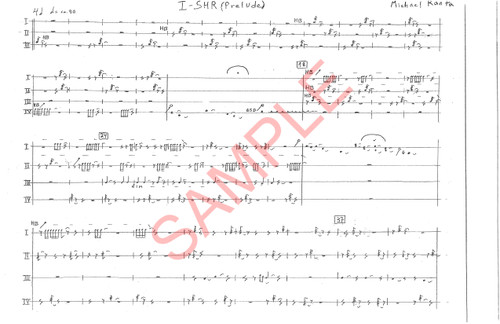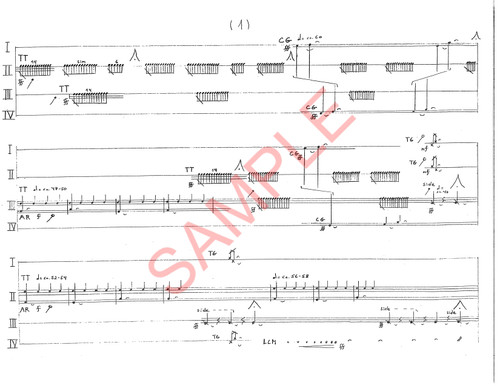Includes score and tape (.wav files).
Print size: 11 x 17"
Review from Percussive Notes (2022):
Michael Ranta’s large-scale, multi-movement percussion quartet, Yuen Shan, originally conceived in 1972 on one of his first trips to China and written in 1998, culminated in 2015 when Ranta released his self-recorded album featuring the four movements. “I-Shr” is the third movement in this massive undertaking, featuring a prelude, the main section with accompanying 8-channel track recording, and a coda. The main section alone (Ranta did not record the prelude or coda for his released recording) has a duration of over 20 minutes and requires almost 50 unique metallic instruments, including many very specific requests. Similar in instrumentation and sound to the more spacious moments in Augusta Read Thomas’s “Resounding Earth,” Ranta’s work requires a sizeable number of resources to procure the necessary metals and sounds.
The score sample on the publisher’s website does not provide a great representation of the majority of the movement, but it would be difficult to find one page to represent almost 30 minutes of music. The prelude and coda use more standard notation, but the main section is written using a timeline and handwritten staves for various entrances. Although there are some difficulties with reading the notation due to the faded copy quality, most of the music is understandable, and an advanced ensemble could assemble this quartet into a meditative product with the right gear. The included three discs contain the eight separate tracks as unlabeled individual files, requiring a DAW and some additional knowledge to piece the electronics together. Although there is not an easy, immediate way to play the track without additional software, the inclusion of each track independently offers performers an opportunity to create a unique soundscape, provided the performing group has access to multiple outputs and speakers.
Beyond the challenges of acquiring instruments, this particular movement does not have many moments of extreme rhythmic difficulty. Most attacks for each ensemble member are isolated and fit within the sustained resonance of the accompanying audio. The tape features several of the same instruments used by the quartet, doubling the size of the ensemble. Combining the sustain of the electronic part with the independent metal attacks in the percussion parts creates an overtone-rich wall of sound that patiently explores the colors of various timbres created from unique gongs, cymbals, and bells.
—Matthew Geiger







